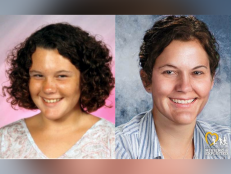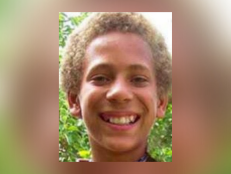Washington Detective Doggedly Pursues Person Of Interest In Decades-Old Cold Case Murders
Jackie Nichols believes DNA evidence is going to be what finally cracks the unsolved crimes.
![COLD VALLEY Asotin County Detective Jackie Nichols [Investigation Discovery]](http://investigationdiscovery.sndimg.com/content/dam/images/investigationdiscovery/crimefeed/legacy/2018/11/Jackie-Nichols-ID-11272018.jpeg.rend.hgtvcom.616.411.suffix/1542839507336.jpeg)
Asotin County Detective Jackie Nichols [Investigation Discovery]
LEWIS CLARK VALLEY — In the three years between 1979 and 1982, four females and one male vanished into thin air along the border between Idaho and Washington. Only three of the missing young people’s bodies were recovered, and clues in the cold cases point to a person of interest who the police have had in their crosshairs for decades — but arresting the potential serial killer is easier said than done.
Jackie Nichols, 54, has been investigating the disappearance of 12-year-old Christina White — the first of the five in the area to go missing — since she became a detective in 2007 with the Asotin County Sheriff’s Department in Washington.
“I was interested in looking up that case and going through it and seeing if there was anything new that could be done to resolve it,” she told CrimeFeed, noting that the mystery “bumps up against the other cases, and they’re all kind of intertwined.”
On April 28, 1979, White’s mom dropped her off at her friend Rose’s house and watched her go in. During the day, White, who had problems with her body getting overheated, called her mother from the friend’s house to tell her she wasn’t feeling well. Her mom told her to use a cold towel to cool down and then ride her bike home.
White never made it.
Accounts have varied through the years about who was present at the friend’s home the day the pre-teen went missing. “The boyfriend of the mother may have been [there],” according to Nichols, who said police records indicate the man “was not at work that day.”
Not long after White’s disappearance, her school papers were found scattered on the outskirts of Asotin, but her body has never been located.
Almost two years later, on the morning of June 26, 1981, University of Idaho student Kristin David, 22, embarked on what was to be a three-hour, 30-mile bike ride from her school in Moscow, Idaho, to the Lewis Clark Valley. Like White, she failed to arrive at her destination.
On July 4, 1981, a fisherman happened upon a garbage bag floating in the Snake River. Inside, he made the gruesome discovery of what would turn out to be parts of David’s dismembered body wrapped in newspapers. Police would go on to recover a total of five bags. To this day, there is debate whether the murder fits the pattern of others in the area around the same timeframe.
![COLD VALLEY Investigators recover Kristin David' s remains from the Snake River [Investigation Discovery]](http://investigationdiscovery.sndimg.com/content/dam/images/investigationdiscovery/crimefeed/legacy/2018/11/Snake-River-ID-11272018.jpeg.rend.hgtvcom.616.411.suffix/1542839498447.jpeg)
Investigators recover Kristin David's remains from the Snake River [Investigation Discovery]
Related or not, just 14 months later, three more people seemed to fall off the face of the Earth.
On September 12, 1982, Kristina Nelson, 21, and her 18-year-old stepsister, Jacqueline “Brandy” Miller, went missing from Lewiston, Idaho. Police said Nelson and Miller left a note indicating they were going to walk to the store and then go do their laundry.
That same night, authorities later learned, Steven Pearsall, 35, also vanished after he went to the Lewiston Civic Theatre to practice his clarinet and do laundry. Though he left behind his car, paycheck, and beloved instrument, which his family insisted he would never do, Pearsall was initially considered a viable suspect in the case of Nelson and Miller’s disappearances because he knew the girls and they may have encountered each other at the theater that night.
On March 19, 1984, the skeletonized remains of Nelson and Miller were discovered in a remote area near Kendrick, Idaho. Pearsall, to this day, is still missing.
“I believe Steven is a victim,” said Detective Nichols. “He doesn’t have the personality, really, that fits the profile of someone that would commit the homicides, and, by all accounts, he was kind of a more mild, low-key type of person, pretty passive, not prone to temper.”
She added, “I think he walked in on something horrific happening that he was a witness to, and that that was the end of his life right there.”
The person of interest in the earlier White case later admitted to police he was working in the theater around the same time and the same night Nelson, Miller, and Pearsall may have all been there, but he insisted he hadn’t heard or seen anything out of the ordinary.
“Once the name of the suspect came up, it was kind of a trigger for law enforcement because this person had also been living at the home where Christina White disappeared from in 1979,” said Nichols.
The person of interest refused to take a lie-detector test at the time on his attorney’s advice and moved to North Carolina in the late 1990s.
Fighting time and with scant evidence, Nichols and law enforcement in this region of the Pacific Northwest are still trying to do everything in their power to find justice for the murdered and missing victims and their families.
“I really feel that DNA is going to be what cracks the case — that we’re either going to find some evidence that still has suspect DNA in one of our cases, or he’s going to be linked to another case somewhere he’s lived that has suspect DNA,” said the detective.
In the meantime, Nichols, who keeps a photo of White on her bulletin board at the Asotin County Sheriff’s Office to remind her of what’s at stake, is “very hopeful” the cold cases will soon be solved.
She even wants to extend an invitation to the killer to step forward after all these years.
"Maybe they could brag to us and give us the answers that way,” she challenged. “Tell us how we failed in order for us to resolve these.”
Watch the two-hour premiere of Cold Valley on Thursday, November 29 at 9/8c on Investigation Discovery!
![5-year-old Summer Moon-Utah Wells [via Tennessee Bureau of Investigation]](http://investigationdiscovery.sndimg.com/content/dam/images/investigationdiscovery/crimefeed/legacy/2021/06/summer-wells-missing-062421.png.rend.hgtvcom.231.174.suffix/1624564333414.png)


![A photo of Amanda Nicole Eileen Campbell circa 1991 [left]; A photo of Amanda Nicole Eileen Campbell age-progressed to age 24 (circa 2011).](http://investigationdiscovery.sndimg.com/content/dam/images/investigationdiscovery/crimefeed/legacy/2023/06/the-charley-project-amanda-nicole-eileen-campbell-61323.png.rend.hgtvcom.231.174.suffix/1686670932019.png)

![Ilene Rebecca Scott at 6 years old circa 1980 [left]; An age-progressed photo of what Ilene Rebecca Scott would look like at 38 years old [right].](http://investigationdiscovery.sndimg.com/content/dam/images/investigationdiscovery/crimefeed/legacy/2023/06/ncmec-ilene-rebecca-scott-60623.png.rend.hgtvcom.231.174.suffix/1686065847762.png)

![Lenoria Jones pictured at 3 years old [left]; Lenoria's photo is shown age-progressed to 16 years [right].](http://investigationdiscovery.sndimg.com/content/dam/images/investigationdiscovery/crimefeed/legacy/2023/03/ncmec-lenoria-jones-31723.png.rend.hgtvcom.231.174.suffix/1679081557653.png)

